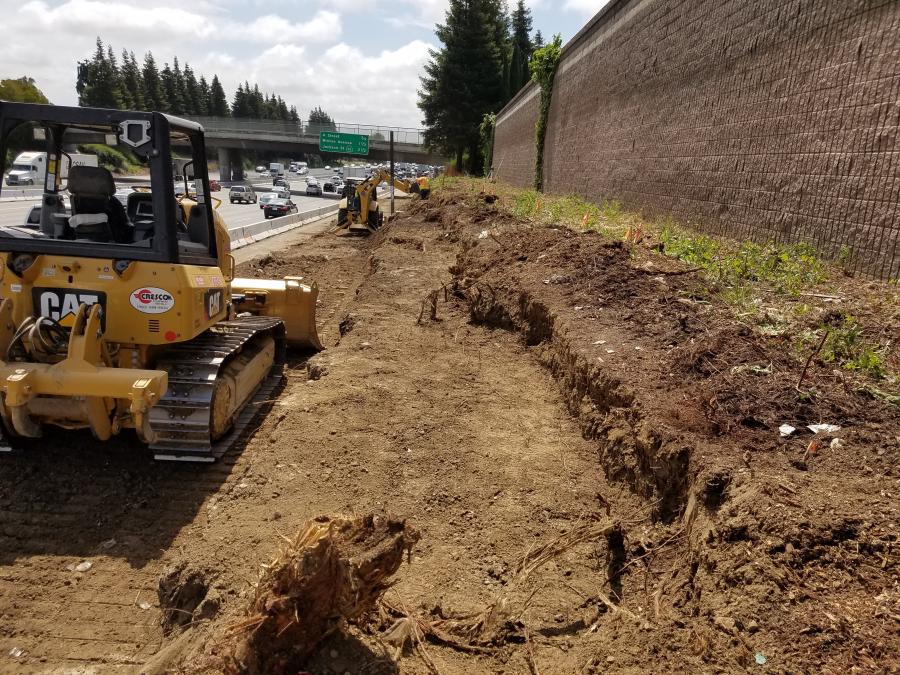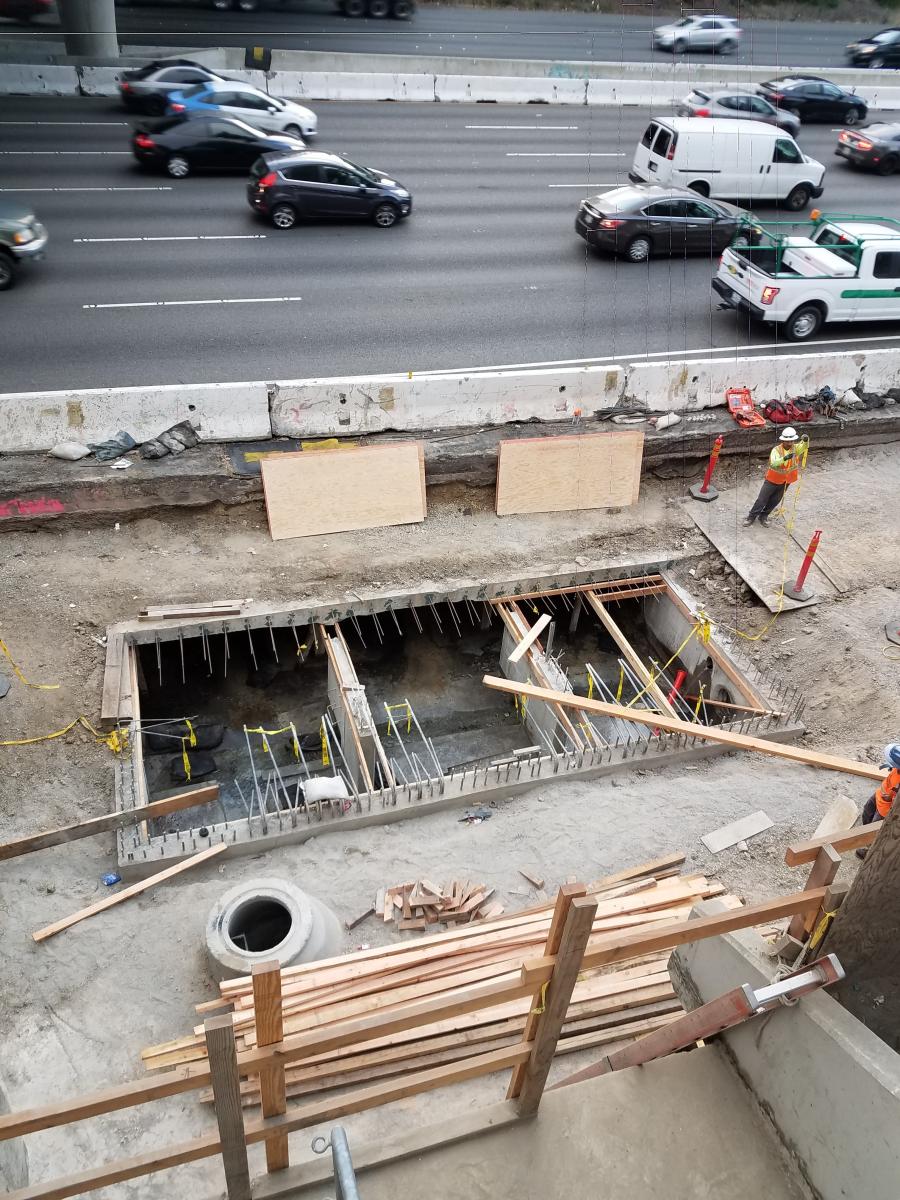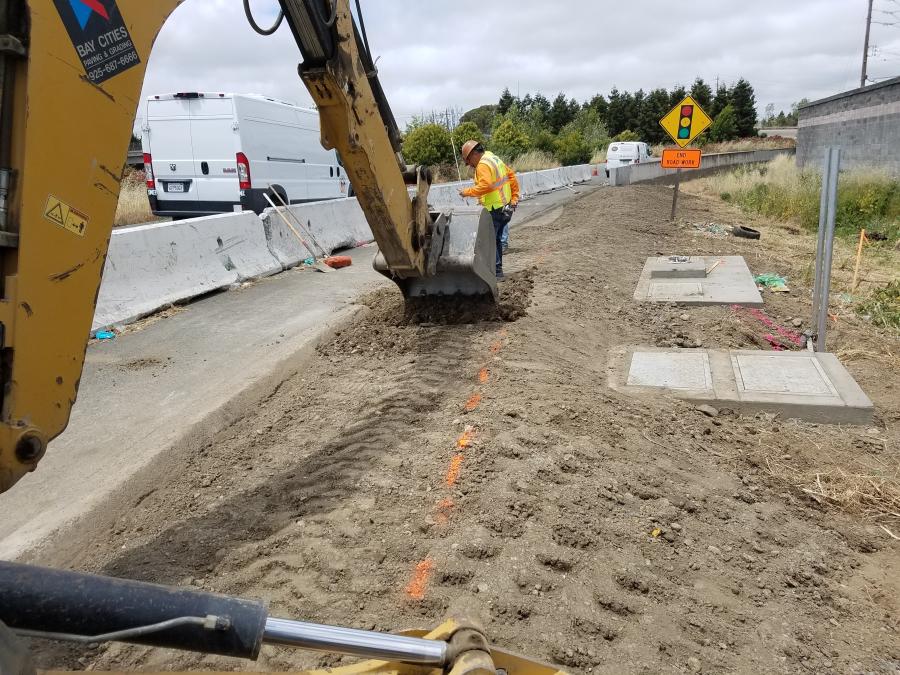Bay Cities Paving & Grading is building an additional 20-mi. northbound express lane from Dixon Landing Road to Lewelling Boulevard and a 25-mi. southbound express lane from Hegenberger Road to Dixon Landing Road.
(Bay Cities Paving & Grading Inc. photo)
Bay Cities Paving & Grading Inc. is on target to deliver the Metropolitan Transportation Commission's (MTC) $139 million I-880 express lanes project between Oakland and Milpitas in late summer, an initiative that will create 45 mi. of new express lanes.
The project, which began in September 2017 from the southern end towards the northern limit of the corridor, will see the addition of a 20-mi. northbound express lane from Dixon Landing Road to Lewelling Boulevard and a 25-mi. southbound express lane from Hegenberger Road to Dixon Landing Road.
Close to three miles of new lanes were constructed by Bay Cities at three locations, which also installed overhead sign structures, new drainage improvements, retaining walls and weave/merge lanes areas to help people get in and out of the express lanes.
The total cost is approximately $139 million, which includes planning, design, construction, utilities and toll system integration. Bay Cities' contract is worth $43.9 million.
The existing I-880 HOV lanes are being converted into express lanes, and that involves restriping lanes and installing lighting, sign structures, signs, FasTrak toll tag readers and other tolling technology, traffic monitoring video cameras, a data communications network and CHP observation areas. The road widening that created merge lanes between the express lanes and the general purpose lanes is being coordinated with Caltrans, including the replacement of the median barrier on I-880.
Bay Cities has completed the capital construction elements, and the remaining items include the permanent striping, which began on June 1, and the removal of temporary signs that are being replaced with permanent signage for the express lanes along the sides of the highway and on the overhead sign structures.
Overcoming Obstacles
An added challenge for the excavation of the new lanes was the lead contaminated soil.
"There was a misclassification of it and we approached BAIFA to re-test and classify a lot of the soil," said Nott. There were three types of roadway excavation — regular clean dirt, ADL with a lower amount of lead that can be reused or taken to a common facility and Type 2 ADL, which has to go a hazardous material facility and we only have one in California — Buttonwillow, near Bakersfield. We had to change our methods. Instead of digging it out, we had to break it up and dispose of it according to the new test results."
To prevent the spread of dust, the soil was wetted down and then placed on trucks for removal. A street sweeper was also used to clean the area. Material removed included 7,400 cu. yds. of non-contaminated material, 900 cu. yds. of ADL Type Z-2, 6,200 cu. yds. of ADL Type COM, and 1,200 cu. yds. of structural excavation for retaining walls.
After excavating each section, crews would install the new drainage infrastructure and place the subbase, lean concrete base and asphalt surface. The three widening sections were spread out over a large area and each one had different milestones.
"There were times when we would work at two locations at the same time," said Nott. "The crews developed a good rhythm."
Bay Cities's work at the Hacienda widening site was impacted by an existing Caltrans pump station and underground storm water storage box.
‘They were full of debris and trash and they pump station did not function properly," said Nott. "This created some flooding and we spent a lot of time cleaning both structures out to get them somewhat functional so that we could continue our work. We had to do an extension of the storage box. In many ways, this job turned out to be an almost complete design change around the existing facilities."
The restriping operations went smoothly, as did the installation of the overhead signage structure and new lighting systems and poles. This work was often coordinated with TransCore, which installed the FasTrak toll tag readers and other tolling technology, traffic monitoring video cameras, data communications network and CHP observation areas.
"It was straight-forward work," said Nott. "With the survey staking, we knew exactly where the center lines had to go and where to drill for the overhead signs and light structures."
Due to the limited hours for night work, extensive planning was required to maximize operations and clear the work sites for the morning traffic.
Project Challenges
The project has been a challenging one for the general contractor, but solutions were found for those that arose.
"The biggest challenge was the unforeseen buried utilities," said David Nott, Bay Cities project manager. "There are a lot of existing Caltrans electrical and drainage systems that were either not shown on the plans or in the correct configuration. We had to modify some of the structures, and sometimes we had to go back to the designer to get their blessing for the modifications to change our plans. Other times decisions were made in the field by the inspectors on how to move forward. Finding out what was working or not was also a challenge — a lot of times we found out that they were abandoned. If they were live and functioning, we had to wait to proceed."
Day and night operations were a staple for the construction, especially for the overhead sign installation and the temporary striping that often took place in the median area, and temporary K-rail was used to protect the workers and motorists.
Materials
New materials brought in included 4,200 cu. yds. for the aggregate base, 3,500 cu. yds. of LCB, and 8,400 tons of hot mix asphalt.
In order to complete the work, Bay Cities is utilizing various pieces of equipment, including a Cat 235, 328 and 335 excavators; a Cat D5 dozer; a Cat 950 loader; a Cat AP1055E paver; Cat and Hamm rollers; a Cat 420 backhoe; a Cat 140 blade; a Grove 90-ton crane; and a LoDril TR 80 110,000-lb. drill rig.
Independent Structures Inc. utilized the following equipment: a Grove 90-ton truck crane, a Komatsu 336 with a LoDril attachment TR 80. (110,000-lb. drill rig), an APE 250 vm pile hammer to drive casings at 60-ft. depth, a 36-m Schwing concrete pump, Dragon 6,000 gal. vacuum tanks and Dragon 21,000 gal. vacuum slurry storage tanks.
Bay Cities has a shop 40 mi. from the construction site and mechanics can easily be dispatched to it rapidly effect repairs.
"Our equipment is serviced daily," said Nott. It is fueled and lubed and the oil is checked daily. If there is a break down, it is usually repaired the same day. It's a team effort. If the operators or lube guys see something, they'll mention it."
Equipment involved in the excavation of contaminated materials were cleaned at the end of shifts.
The company purchases and rents it equipment from Cresco Equipment Rentals, Sunbelt Equipment Rentals and Sunstate Equipment Rentals.
"A lot of equipment was rented for this project," said Nott, who noted that rented equipment was primarily serviced by the dealerships. "We have a long running relationship with our dealerships — they appreciate our business as much as we appreciate theirs. Open and honest communications are crucial and we try to give them as much lead time as possible – we don't call them up and say that we need this piece of equipment tomorrow.
"We want to give them advance notice, especially during the busy seasons so they can meet the demands of their clientele," he added. "Planning ahead and scheduling our equipment needs is a big thing."
Managing the Project
With so many variables out of Bay Cities control, patience was key to managing this multi-year project.
"We are adjacent to ongoing Caltrans projects and you have additional MTC projects like the Tolling System Integration contract," said Nott. "Their work impacts our schedule to some extent. It's all about coordination and seeing the big picture to get things done."
Two of the five weave lanes did not require any construction, with the other three connected to the widening operations.
The road work was complicated due to the drainage and electrical infrastructure that needed to installed or relocated. Pulling new fiber optic line for the express lanes was important.
"A lot of it was supposed to be pulled through existing empty Caltrans conduit, and some of the existing conduit was not where it was shown or could not be used," said Nott.
A majority of the widening work occurred adjacent to sound wall and for the road work adjacent to homes and businesses, a public outreach campaign notified people when the operations would take place.
Peak days had between 30 and 40 Bay Cities and subcontractor employees on-site, with the major subcontractors being Avar Construction, Inc., Bridgeway Civil Constructors, Inc., Chrisp Company, Independent Structures, Inc., Sturgeon Electric California, and Vanguard Construction.
Project Background
I-880 is owned by the California Department of Transportation (Caltrans), including the right-of-way, but the MTC operates the express lanes. The Bay Area Infrastructure Financing Authority (a subgroup of MTC) is funding the project. The MTC is the transportation planning, financing and coordinating agency for the nine-county San Francisco Bay Area.
Prior to the work, the section of I-880 was five-lanes in each direction throughout most of the corridor.
The promotion of carpooling to help reduce traffic volumes on a stretch of highway that carries some 300,000 cars and trucks daily is a crucial element. A new toll ordinance adopted by MTC last January calls for cars with three occupants to be exempt from the toll, while those with two occupants will receive a 50 percent discount, and solo drivers pay full price.
"Given the incompatibility of promoting carpooling while also encouraging social distancing during the Covid-19 pandemic," said John Goodwin, assistant director, communications of MTC/Bay Area Toll Authority, "MTC may opt to delay the introduction of tolls for two-occupant vehicles until sometime after the Express Lanes open for business."
Between 2015 and 2040, the Bay Area's population is expected to grow about 25 percent and employment about 17 percent.
"Funding and land to expand the transportation network are limited, so the region needs to move more people on the existing network," said Goodwin. "Today, Bay Area carpool lanes, including I-880's lanes, rarely provide the speedier trips that carpools and buses deserve. Express lanes can decrease carpool lane congestion by allowing three-plus carpools to travel toll-free and encouraging two-person carpools and clean air vehicles with partial tolls.
Caltrans points out that express lanes allow for more reliable trips; ensure use of all lane capacity; reduces carpool cheating; provides tools to manage traffic flow and give more vehicles the opportunity to use the lanes; grows the carpool lane network; and funds operations and maintenance with user fees.
The project was designed by HDR, Inc. Key concerns regarding the construction plan were coordinating the effort with ongoing projects in the corridor and I-880 traffic volumes and patterns - heavy truck traffic and commute traffic.
"Protecting express lanes infrastructure from inadvertent damage was important," said Goodwin. "The approach to dealing with all these issues was creating partnerships with other projects/agencies and communicating extensively to identify and resolve any issues."
Social media and email are being utilized to inform motorist about construction and traffic updates. Temporary lane closures continue as the work proceeds, particularly for night operations.
The tollway systems are being installed and tested by TransCore.
This work is being done at night via lane closures by Independent Structures, a subcontractor with vast experience in this field. These operations will have crews using boom lifts.
"They've been doing this on multiple corridors and are proficient in their means and methods," said Nott. CEG
Irwin Rapoport
A journalist who started his career at a weekly community newspaper, Irwin Rapoport has written about construction and architecture for more than 15 years, as well as a variety of other subjects, such as recycling, environmental issues, business supply chains, property development, pulp and paper, agriculture, solar power and energy, and education. Getting the story right and illustrating the hard work and professionalism that goes into completing road, bridge, and building projects is important to him. A key element of his construction articles is to provide readers with an opportunity to see how general contractors and departments of transportation complete their projects and address challenges so that lessons learned can be shared with a wider audience.
Rapoport has a BA in History and a Minor in Political Science from Concordia University. His hobbies include hiking, birding, cycling, reading, going to concerts and plays, hanging out with friends and family, and architecture. He is keen to one day write an MA thesis on military and economic planning by the Great Powers prior to the start of the First World War.
Read more from Irwin Rapoport here.
Today's top stories


















